Conserving a unique traditionally mounted East Asian scroll in Dr. Barbara Piscitelli’s Children’s Art Archive
By Jennifer Loubser, Conservator, Preservation Services | 14 April 2021
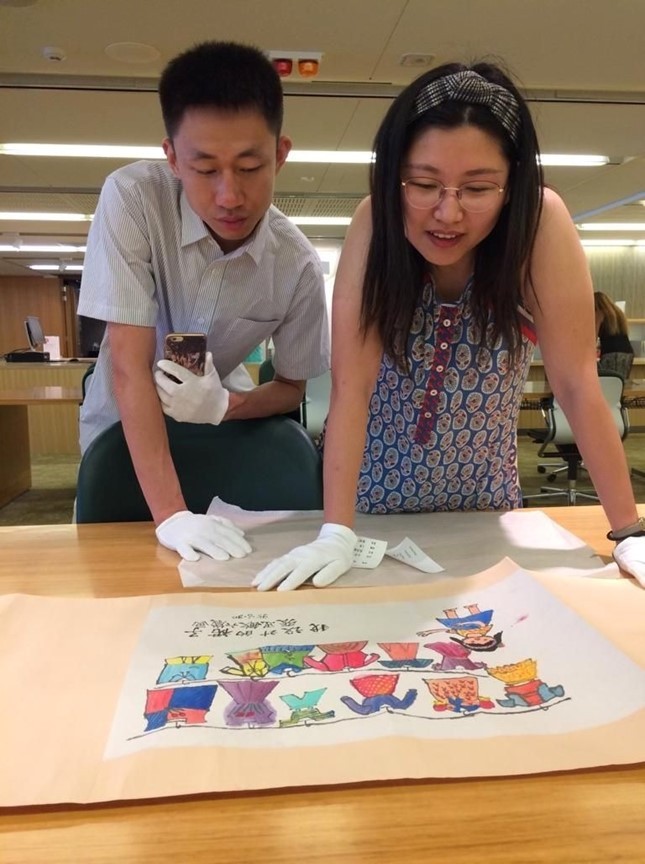
Simin Zhang and her husband Sky viewing her scroll at State Library of Queensland. Photo courtesy of Dr Barbara Piscitelli AM, 2019
‘My Dress Design’ by Simin Zhang, aged 6, from Huangzhou, Hubei, China.
Watercolour on Chinese bamboo paper, mounted as a scroll, 1995.
State Library of Queensland. ACC 7116/2/171
Link to record
Link to digitiesd item
A memory surfaced with great emotion when Simin Zhang had the opportunity to visit State Library of Queensland and see a watercolour artwork she painted as a child. Her watercolour painting on bamboo paper is mounted for presentation as a traditional Chinese scroll. Simin Zhang had worked with her father in his art studio 25 years earlier, creating this scroll according to cultural tradition.
This scroll painting was originally created as part of an international research project spanning 30 years. Dr Barbara Piscitelli AM and colleagues studied and collected children’s artistic responses from Queensland, China, and Vietnam creating a 15-part series Children’s Art Archive, now in the custodianship of the State Library of Queensland. The purpose being to gain insights into children’s life perspectives. The artworks depict their social worlds, their human rights and their futures.
Today, Simin still lives in Hubei, China, she studied engineering at University of Massachusetts in the USA, and continues designing her own dresses. Now as adults like Simin, some past child artists have been able to visit the State Library and see their childhood artworks either in the conservation lab being treated or on exhibition. It has been an enlightening opportunity for us to speak with and meet some of the young artists from these projects.
25 years later, time has not been kind to Simin’s scroll: the paper borders had begun to crack away where they were originally attached to the hanging staves
Over time, without a round rod on which to secure the scroll for ease of unrolling and viewing, vertical creases developed and had appeared throughout the scroll. At the far edges, these creases had become cracks, the pink paper borders torn. Some of the extremely pronounced ridges were extending into the painting. Raking light across the surface emphasises how these creases had also caused lining paper layers to delaminate from the outer edges in towards the painting.
The scroll’s original construction, combined with frequent handling and storage conditions, had caused these damages. If not addressed, these issues would soon start to abrade the pigments in the image area painted by Simin.

‘My Dress Design’ by Simin Zhang before and after conservation treatment.
(Left): Mountainous creases, 2019
(Right): Resting flat again after conservation, 2020
Have you ever noticed the many different presentation formats for East Asian scroll paintings? The design of borders for scrolls depends on the display occasion, the level of formality expressed in the painting, the era and nation of origin.
Something different about Simin’s artwork and somewhat unusual, are the half-round hanging staves/rods, mounted at each end of this scroll with hanging ropes. Perhaps this mounting it is a reflection on the way the dresses are hanging across the lines. Peachy pink paper borders surrounding the artwork could have been chosen to emphasise the casual, happy intent of the painting.
Both ends of this scroll mounted as a hanging system allow for the scroll to be exhibited on a wall in landscape format. However, over time the edges had torn apart from the hanging staves, making the structure too weak to withstand hanging.
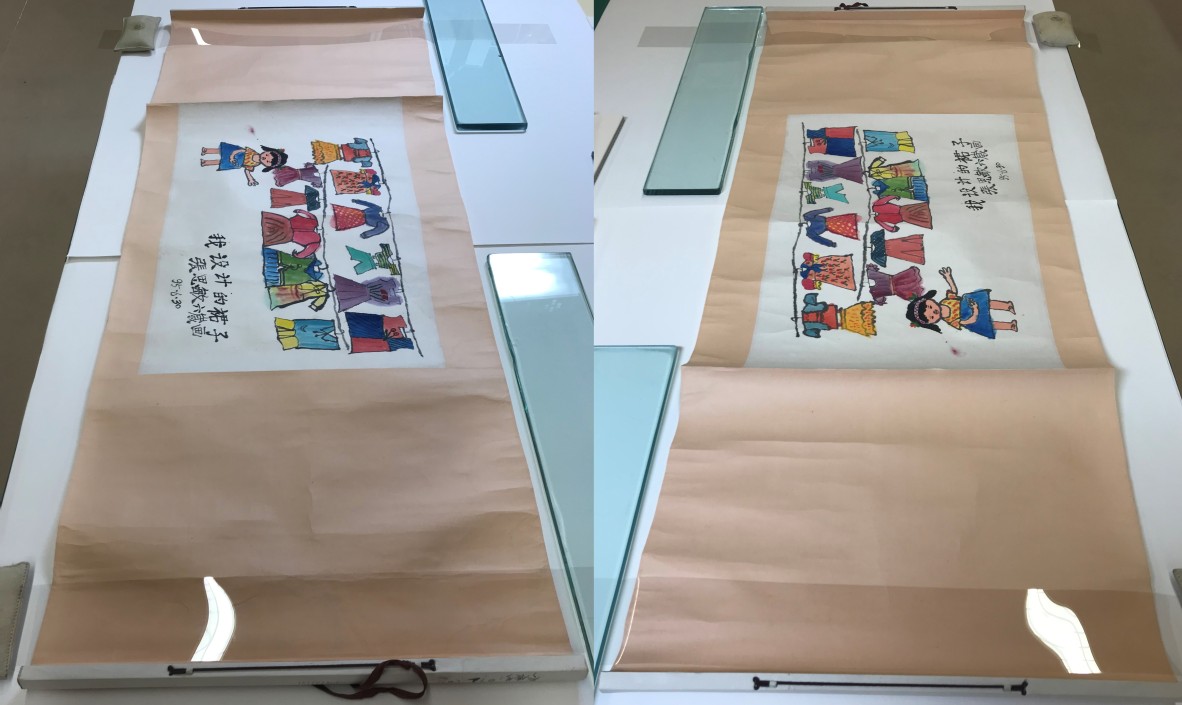
Before conservation: two views in raking light angled across the artwork, highlights damages to the artwork’s borders.
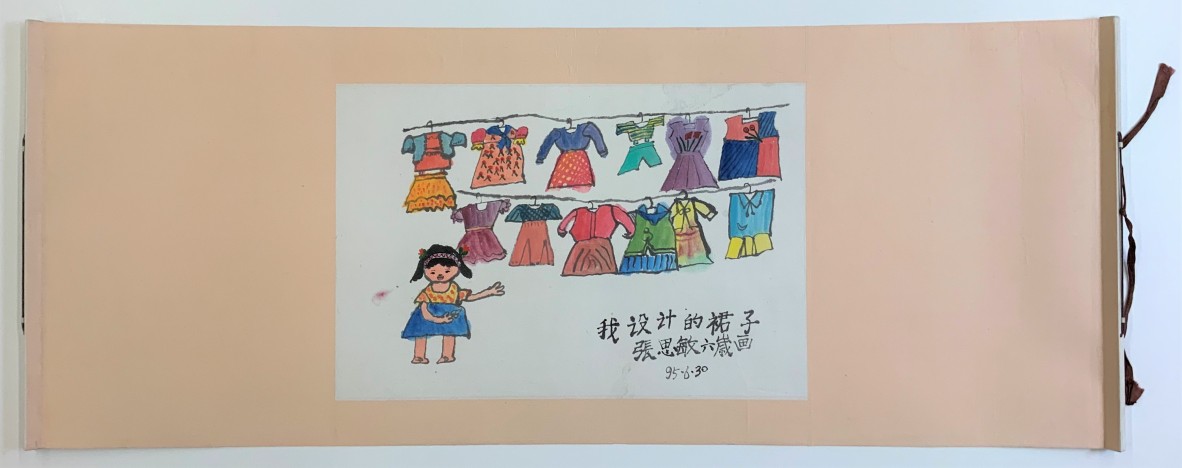
After conservation. Translation of inscription: “Dresses I Designed” By Simin Zhang, 6 years old, 30 June 1995.
The scroll was selected for display in “Big Voices: Children’s Art Matters”
As exhibition preparations progressed, conversations began between Barbara Piscitelli, Simin Zhang, the exhibition curator Stella Read, and myself as Paper Conservator, Jennifer Loubser.
My recommendations included stabilising the failing structure before damages, apparent in the borders, continued inward to deteriorate the watercolour painting. While a complete remounting would be ideal to prevent further delamination and creasing in the long term, there wouldn’t be enough time prior to the exhibition. Minimal intervention was needed with maximum results. Together it was decided that I would undertake stabilisation of the scroll structure, while it was of utmost importance to retain every element of the original artwork.
This began a unique journey for us all, we kept in touch with Simin throughout the entire process. We couldn’t have imagined that this project would see us working through and reaching out during a global pandemic. Each time we sent a photo across continents during the process of repairing the damage to this artwork, we would learn something new from Simin in her response. It was akin to casting rays of sunshine across otherwise overcast skies.
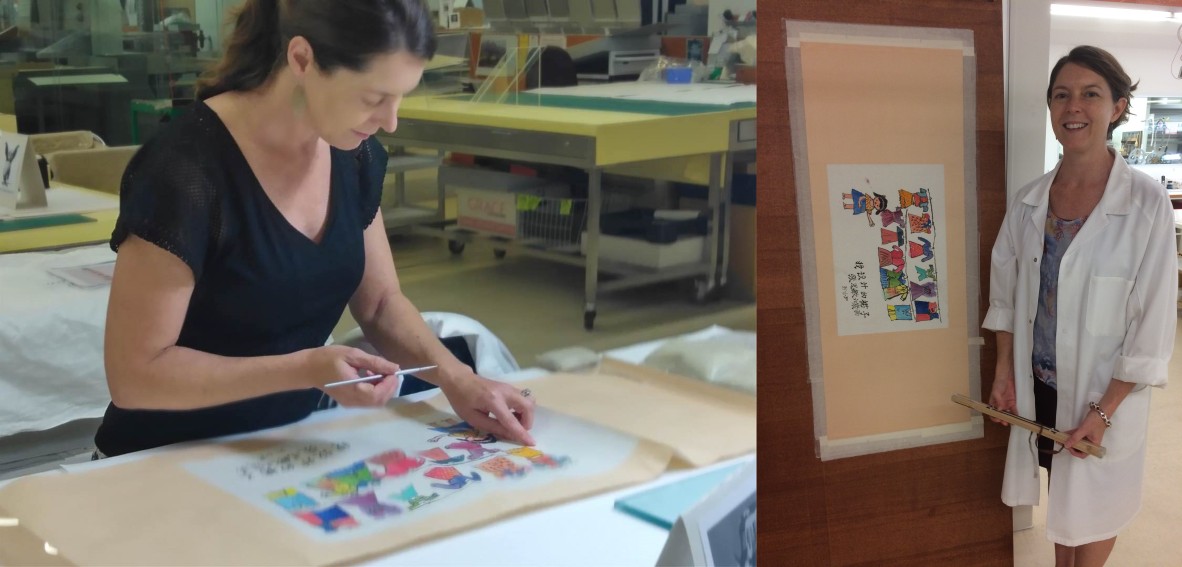
(Left): Conservator Jennifer Loubser testing stability of pigments.
(Right): Jennifer with scroll flattening on karibari.
Conservation of a fragile scroll began, restoring hopes and dreams.
Mountains of weakened creases were relaxed when I supported the scroll with reinforcing tissue strips and a delicate lining of pure mulberry paper. For scrolls it is important to use techniques that maintain the rolling movement in the artwork, so I chose to use these in combination with aged starch paste for flexibility, a 300-year-old tradition in Asia. I also used a traditional East Asian karibari (drying board) for flattening. By only using extra paper added around the outside edges, I attached the artwork to the board to achieve a centuries-proven East Asian technique. The fragile paper of this scroll floats on a cushion of air as it flattens slowly and securely under even tension. This method is ideal as the face of the original artwork remains untouched, a perfect flattening process. Using the karibari has allowed us to provide the best care for many types of fragile works on paper, including watercolours, maps, plans, screen prints and other East Asian paintings in the Library’s collections.
Where the half-round timber hanging staves were becoming detached from the ends of the scroll, the paper had also torn. Flexible paper attached to solid timber is always an area exposed and prone to damage. The staves were removed so the torn areas could be strengthened. At the scroll ends I attached stronger mulberry papers before re-attaching the staves. I was able to leave the original hanging ropes in place, preserve the title bar inscription on the outer paper of the scroll, and keep all original elements of the scroll intact. Successfully conserved, this scroll can again be viewed as created by Simin in her original intention, for many generations yet to come.
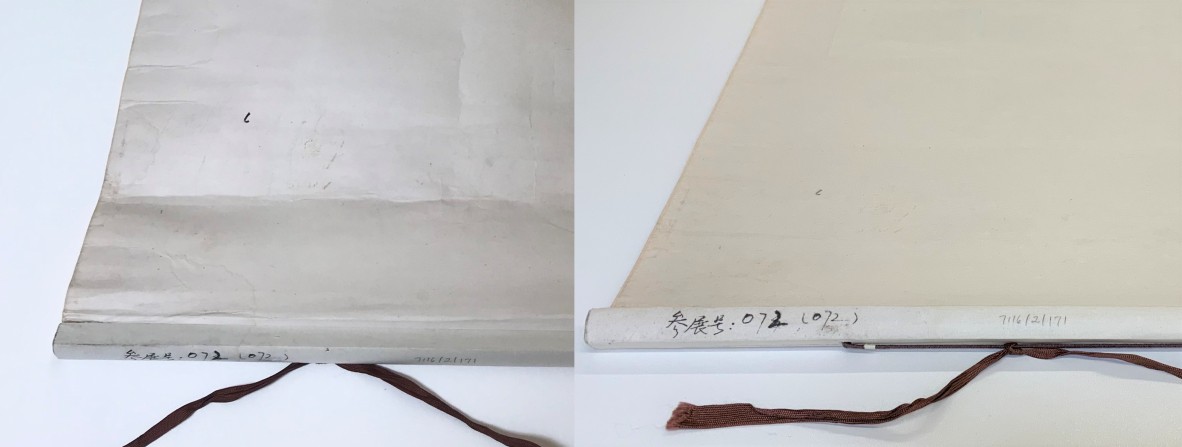
(Left): Before conservation, hanging stave, creases.
(Right): After conservation, creases reinforced, flattened.
Inscription translation: Exhibition Artwork # 72
The exhibition curators have decided to display the scroll with the best long-term preservation interests in mind. In the same way as a handscroll, or rolled book format, it sits flat on display. Both ends of the scroll’s paper borders are gently rolled inward to draw attention to its different format. I hope that the next time you come across a traditional East Asian scroll painting, you will take time to look carefully. See if you can notice any differences in the presentation borders that make the artwork a scroll, and whether it appears complete as it would in its original authentic condition.
It has been a wonderful journey for me to preserve this unique artwork in the children’s art archive. While conserving this scroll for display, being able to connect with Barbara the project creator, and Simin the artist, was a rare experience. Conservators’ work is rarely needed while the artist is still able to be involved. Usually a scroll would only need remounting every few hundred years, depending on its display and storage conditions. This artwork needed repairs much sooner as it had been handled and admired in China and Australia through multiple exhibitions over the years.
The opportunity has certainly lifted my spirits through collaborations, sharing my expertise and using traditional East Asian techniques to extend the longevity of a Chinese scroll painting. I hope yours lift too when you next have an opportunity to visit the State Library and see it on display. As with all artworks and especially those created by children, the gift is in the presentation.
The Big Voices – Children’s Art Matters exhibition highlights Dr Barbara Piscitelli’s work and the Children’s Art Archive. See this scroll online and on display in the Phillip Bacon Heritage Gallery on Level 4 through 5 July 2021.
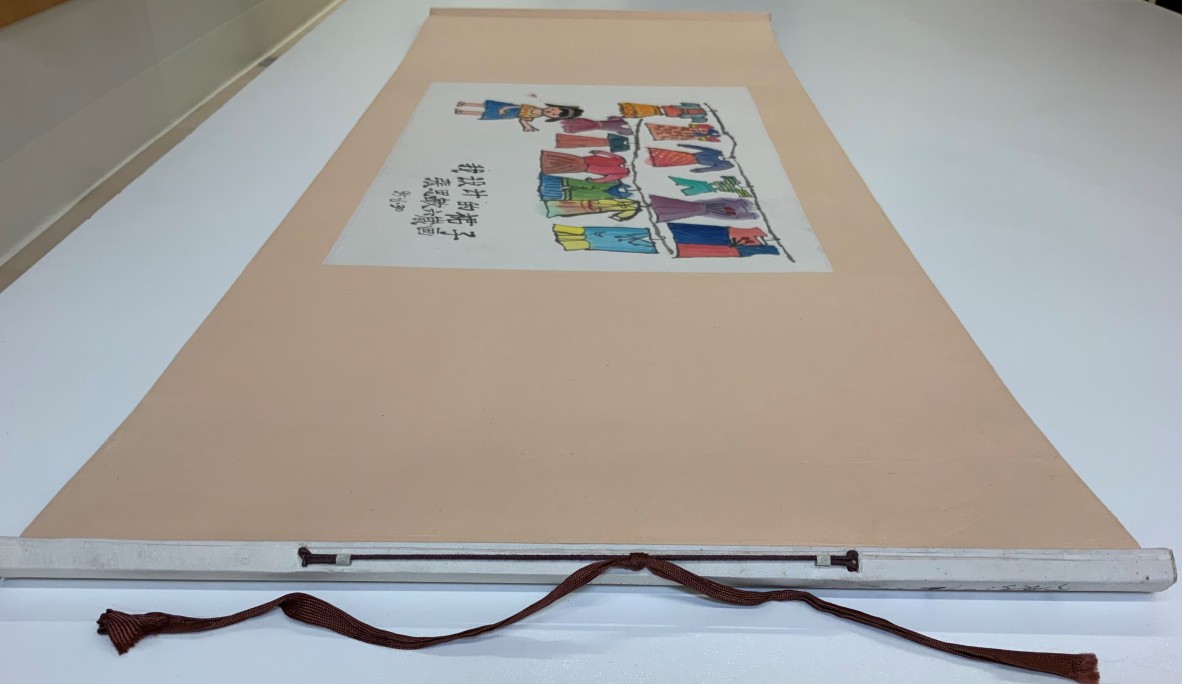
Longevity renewed after conservation. Two views in raking light show this scroll is again flat and safely supported.
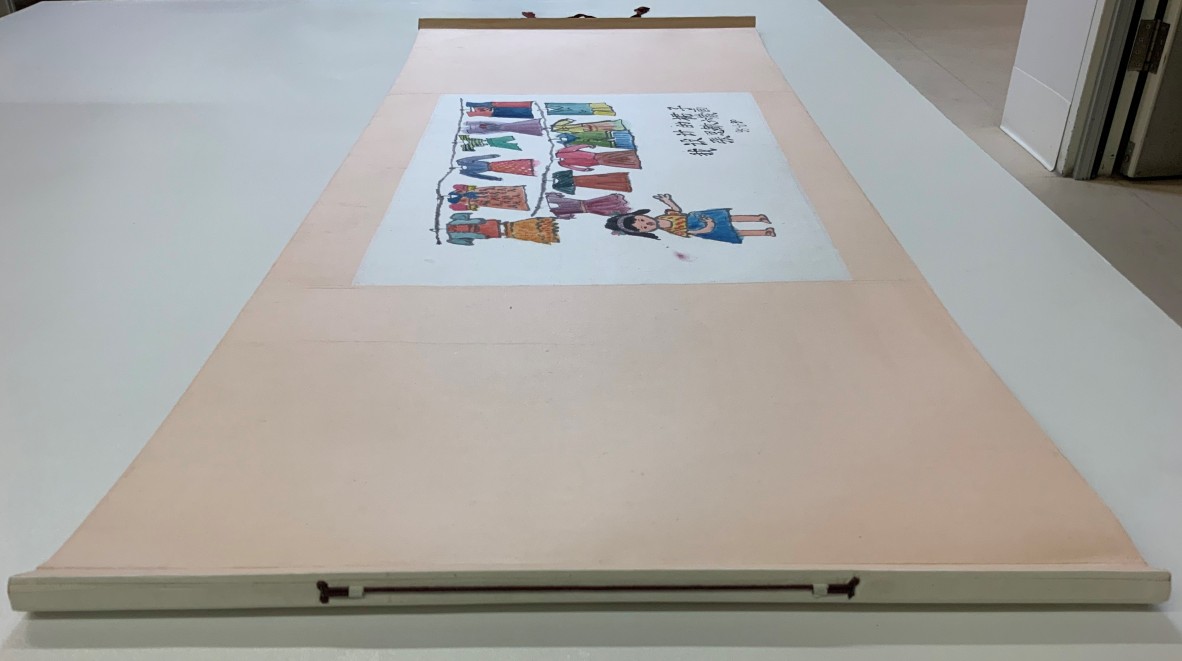
After conservation: stability, strength, and resilience are plentiful.
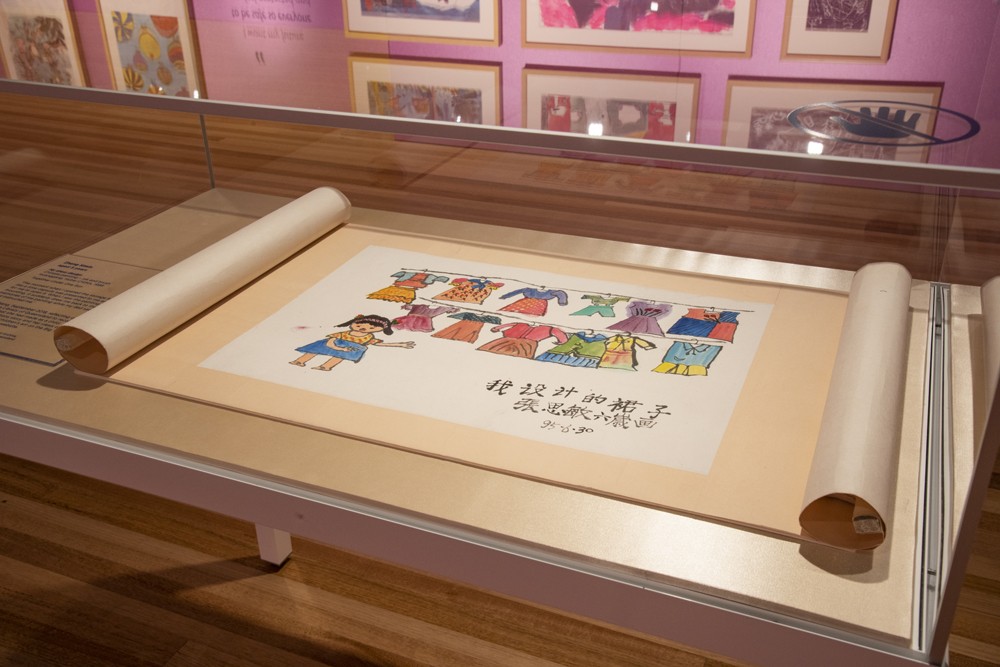
Scroll on display - Big Voices exhibition 2020.
Further Reading:
-
Childhood revisited: cultural exchange through children's art
-
The gift that keeps on giving: Generous progress since a karibari board workshop
-
Big Voices - Exhibition homepage
-
7116 Dr Barbara Piscitelli AM Children's Art Archive 1986-2016; 2020 - A collection of drawings and paintings (works on paper) made by children in Australia, Vietnam and China between 1986 and 2009 and in 2016.
About the author:
Jennifer Loubser has been a Paper Conservator at State Library of Queensland since 2014. She trained for many years in traditional South Korean, and in traditional Japanese paintings conservation studios. At the East Asian Paintings Conservation department of Honolulu Museum of Arts since 2005, she conserved an abundance of ancient and contemporary Chinese scroll paintings. With ongoing cross-cultural collaborations, including traditional karibari drying boards constructed with generous support from Queensland Library Foundation through the 2018 Mittelheuser Scholar in Residence Program, Jennifer continues using East Asian traditions to preserve historic artworks in Australia.
Comments
Your email address will not be published.
We welcome relevant, respectful comments.